Comics as System
In his new column "Line Readings," Ivan Brunetti begins with a close read of a single comics unit—a panel, a page, or a spread—and expands outward to encompass the history of comics, and the world as a whole.
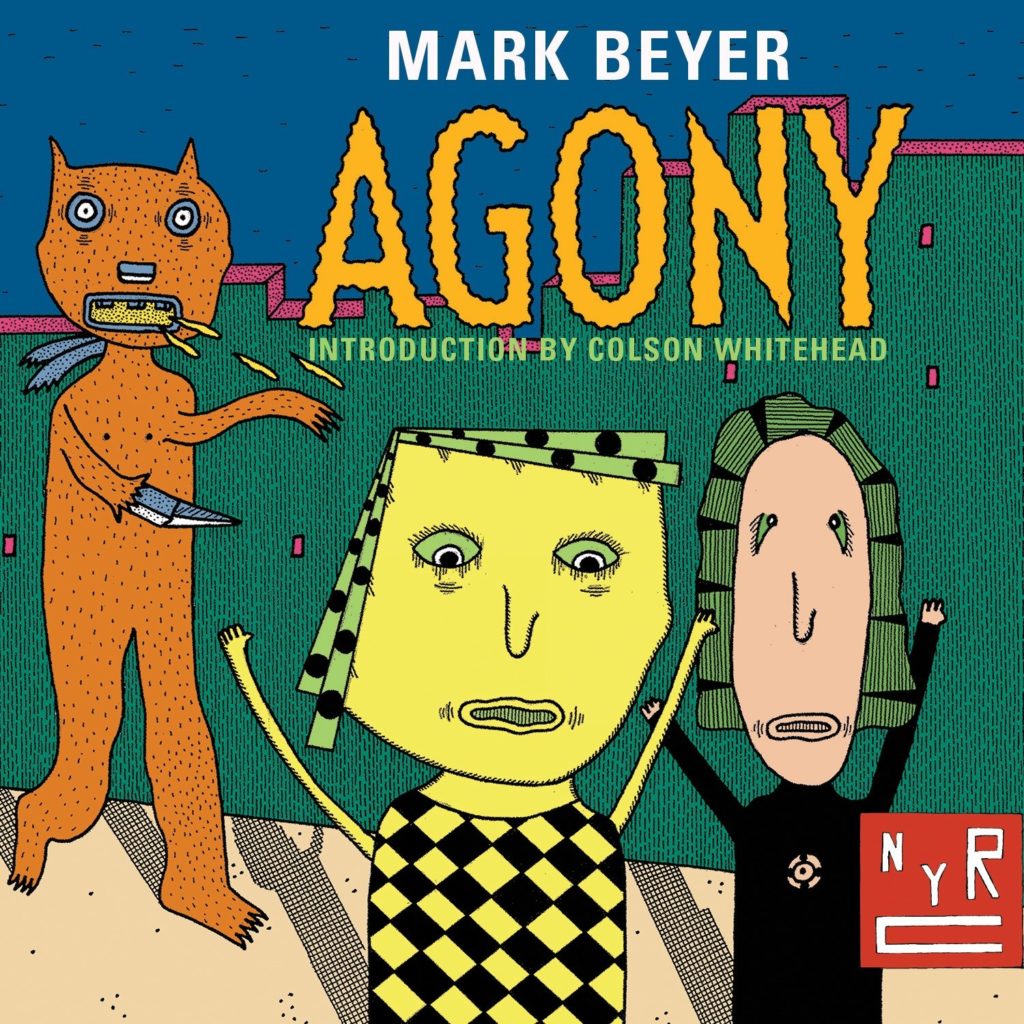
Pictures and words, pictures as words, words as pictures, neither quite pictures nor words: comics are self-contained systems, worlds unto themselves, answering to no one. From one panel, to one page, to one sequence, to one story, to one book, each level of a comic holds a small universe, and each small universe folds out into a larger universe. These systems need basic parameters and a modicum of internal consistency so that they can function not unlike language, but they are also dynamic, fluid, unstable, imperfect, flexible, and open-ended … not unlike language. As we decode them, they reconstitute themselves in our brains as narrative (or poetry, or both). In any one panel, or the spread of two panels, or any given sequence, we glimpse the entire book in microcosm.
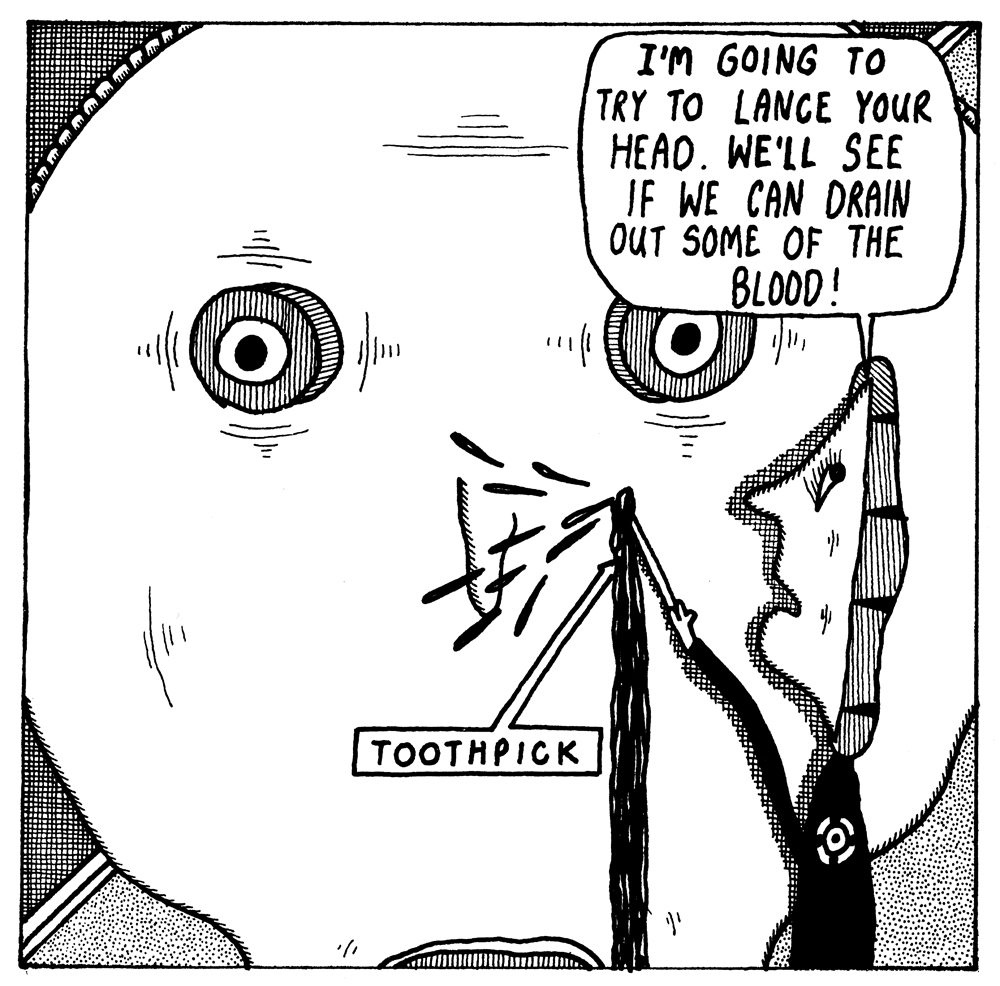
Consider the above panel from Mark Beyer’s 1987 book Agony. What exactly is happening in this strange image? And, stranger still, why is it possible for us readers, with relative ease, to figure it out?
Square, circle, triangle. One can’t get more elemental than this perversely Bauhausian composition. The razor-edged square panel border bounds the image, not quite fully encompassing the large, lumpy circular shape, which turns out to be a head (human? monster? both?). Concentric circles within the circle quickly read as "eyes" and the arc of a possible "mouth" is visible at the bottom of the image. The nose isn’t as easy to discern at first, but once "head, eyes, and mouth" click, we complete the cycle and also see "nose" smack dab in the middle of the image. In this nasal area we also see a confluence of triangular shapes, bringing our eye squarely (sorry) to the center of the composition. Diagonals, which often signify and accentuate motion, activate the image: a gush of blood forms one triangle, the arm holding the stick and the resultant stream of blood another, and the angle of the text label’s arrow (comically but helpfully informing us that this rather unwieldy stick is actually a "toothpick") forms yet one more. Just to the right of center, there is a secondary, much smaller figure/character, whose nose conveniently forms an additional triangle directing us to the center of the image, where the main action resides.
The short crosshatch hugging the outline of this smaller figure read as "shadow"; interestingly, while this shadow suggests that the figure is a flat, cutout doll, at the same time it creates a foreground layer of space: this figure reads as being in front of the large head, and there is even a light source! There are also near-triangles at each corner of the square (actually two triangles at the bottom left), clarifying the figure/ground relationship: these reinforce the idea of the large circle as "head" inside an architectural "space." In fact, the baseboard at the bottom left clearly shows that this background is a room, one inadequately sized for the enlarged head, implying that the head is likely swelling, throbbing, ready to burst.
These spatial relationships are decoded in a microsecond. The text takes us slightly longer to process (say, 2–3 seconds). We discern that only the smaller figure is speaking, the large head eerily silent, helpless. The words repetitively describe what is depicted in the image, violating one of storytelling’s cardinal rules: show, don’t tell (and definitely don’t do both). Here the telling is intentional, slowing everything down, making what should be a horrific and extreme action all the more deadpan. Note the two key, well-chosen verbs in the balloon: lance and drain. The words apply not only to the action in the picture, but also to the action in our minds: the drawing lances our expectations (rules of scale have been violated), and drains the gore. It is at once a drawing both bloody and bloodless; therein, I think, lies its humor.
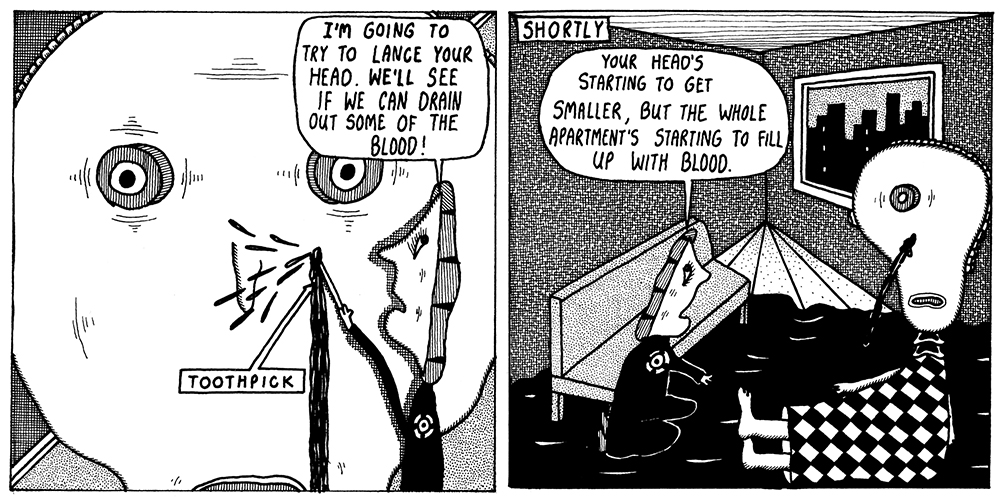
At this point I should mention that the book itself is five inches square, not quite two hundred pages thick, with most pages comprising only one panel. When we open the book, our eyes can’t help but take in a spread of two juxtaposed panels/pages. We absorb each spread quickly, both as one large compositional space as well as one short sequence, before we even have a chance to fully read each panel. In this case, the adjacent page clarifies many things, including: the characters (two humans, and we might guess one is male and the other female, based on their clothing); the setting (a sparse room inside an apartment, with a cityscape visible through a window); the point of view (third person omniscient, always clinging at close range, haunting our characters); the proportions (the woman’s head is shrinking but still oversize); how much time has elapsed (via the caption "shortly"); and the overall situation. No sooner than one predicament has been resolved (the head is getting smaller as the blood drains), the characters are thrust into another conundrum (the apartment is quickly filling up with blood).
A word about the perspective of that room. Or, wait, is it actually perspective? Maybe a paraline drawing? Well, it’s some sort of system of spatial representation, one wholly unique to the artist. The room feels cavernous, with the vanishing points inexplicably visible in the corner of the room, although the perspectives of the ceiling and floor don’t quite match up, and they really aren’t vanishing points, technically. The center cannot hold, and neither can the horizon line, but somehow it does. Note that the ceiling and floor enclose the massively deep space, paradoxically constraining the scene, rendering it claustrophobic. The rising tide of blood only adds to the dread of confined characters running out of time. Although nothing in this book looks quite like our everyday world, on this and every page, we readers always know exactly where we are. We are given often rudimentary visual information, but with just enough detail to decipher it.
If we examine the panels/pages immediately before this spread, we get a fuller sense of the sequence and its context; a partial cutaway view of the apartment informs us that the oversize head is growing at such a rate that it is unable to fit through the door. Fanning out further, we learn the character’s names: Amy and Jordan, the blandness of which flies humorously in the face of the crushing, outlandishly expressionistic horror of their perversely picaresque story. Amy has been reduced to a human skeleton, the flesh melting off her bones, after being exposed to the toxins from an unexplained industrial explosion that killed off all the natives of the island upon which Amy and Jordan were imprisoned; all of this happened because Amy and Jordan were off on an ill-conceived exploratory/anthropological mission, every aspect of which has backfired. In any case, Amy’s flesh has started to grow back, but now her outsize head is rapidly swelling as the result of complications from a postsurgery infection. I’m actually skipping some of the funniest, most savagely satirical parts of the sequence. At one point Amy declares, "things seem so bleak," a darkly funny understatement, applicable to the entire book.
But where do these drawings come from? One’s mind immediately conjures Paul Klee’s puppets, or Kachina dolls, or perhaps George Herriman’s Krazy Kat, with its vast and shifting nighttime landscapes. There is something both cute and nightmarish at work here, something primal but repressed (sex, as such, doesn’t quite exist in the story), but the artwork is original, controlled, sophisticated. This is a style of cartooning arguably never seen before or since; to be influenced by it is, effectively, to plagiarize it. Like much of the best cartooning, it is sui generis; it seems to have synthesized everything and nothing. These comics are similar to young children’s drawings, which are similarly sophisticated in their usage of over-all composition. They also share another quality with both dreams and stories created by children: a free-form, "anything goes" willingness to let the narrative splay where it may, adult logic be damned. (All of the above are sincere compliments.)
Despite the frozen stillness of the individual panels, the story sails. The narrative has no chapter breaks, and the flow of time is staccato, unpredictable, and sometimes absurd: one memorable conversation is interrupted midway by a caption informing us that two weeks have passed between word balloons. The only time a date appears in the story is on a newspaper page, and the year "0000" isn’t much help; meanwhile, the captions are relative only to the story itself ("shortly," "later," "soon," and so on), caging the characters as well as the readers in an arbitrary, oppressive "now" beholden to no outside reality. Agony takes place any-time, every-time, and no-time.
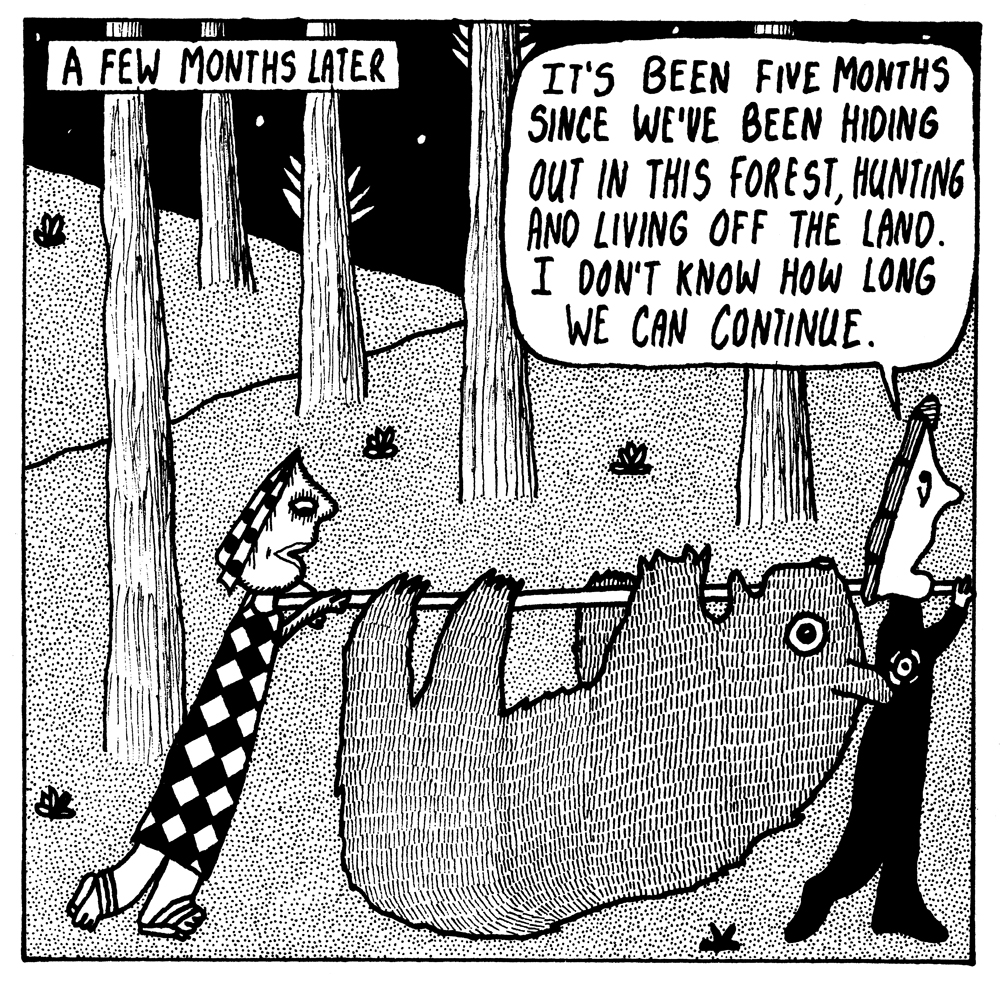
The book uses repetition for comic effect; examples include travel by boat, multiple instances of our protagonists trying to live in nature, and continual confrontations with strange animals and creatures. It also "rhymes" actions across disparate pages: for instance, some physical attacks are positioned in similar areas of the compositions. The characters are stuck in a simulacrum, a capricious, unwinnable video game, always striving but not really advancing. Agony’s world feels like a desktop globe, one with the seas and oceans painted black. The characters may hit dead ends, but the narrative never stagnates; it remains a kinetic feedback loop, suggesting an ailing but pulsing organism. Through the genius of the cartoonist, before we can ask "what?" we instead ask "what next?" Tragedy becomes farce becomes tragedy again becomes comedy, ad infinitum. The tone is one of claustrophobia. Amy and Jordan are hemmed in, battered by the vagaries of randomness and human cruelty, continually pedaling on a wheel of decay, dread, and terror. By story’s end, the pattern is ready to begin all over again.
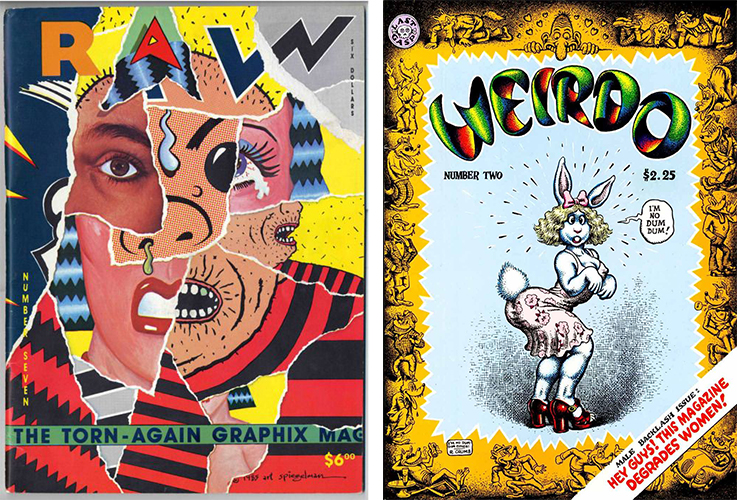
Agony was first published in 1987, by RAW books. The underground comics of the sixties were an integral part of the hippie counterculture, but by the seventies they went even deeper underground, nowhere near as popular and operating under the radar. But what didn’t kill them, made them stronger: in the eighties a renaissance was underway, with some of the sixties artists making their best work, now joined by a new generation of artists inspired by the undergrounds. The eighties coalesced around the twin vortices of two essential anthology magazines: RAW (edited by Art Spiegelman and Françoise Mouly) and Weirdo (originally edited by Robert Crumb, later by Peter Bagge, and finally by Aline Kominsky-Crumb). The work could be trenchant, poignant, formally daring, iconoclastic, but it was always committed to the singular vision of the artist, eventually forging the graphic novel movement of today, and cementing the idea of comics as a worthy form of both art and literature. Agony is an exemplar of that eighties "alternative" comics movement. To this day, I cannot picture that decade through the lens of pop culture, a time of saturated, hot colors; rather, it remains a grim, reactionary era of greed, nationalism, delusional feel-good slogans, an assault on the fabric of our society, a doomsday decade visible for me only through a thick scrim of black and white crosshatch.
Agony’s structure reaches back further in time to the wordless picture novels of the twenties and thirties, pioneered by artists such as Frans Masereel, Lynd Ward, and others. These, too, were "graphic novels," featuring one panel per page, printed in black and white, dense with ink, following protagonists through sometimes harrowing experiences, social and personal upheavals, and parable-like journeys of moral discovery.
Mark Beyer remains an elusive, rather mysterious figure in the world of comics, reappearing every so often. A current biography flatly describes him as a "former cartoonist," which I hope is incorrect. Despite being published by notable houses and periodicals, producing several well-reviewed books, and in the nineties having an animated series on MTV’s Liquid Television, he remains an "outsider cartoonist" appreciated mostly by aficionados, never quite breaking into the mainstream psyche, gallows humor evidently not being everyone’s cup of tea.
New York Review of Comics reissued Agony in 2016 (with an excellent introduction by Colson Whitehead). The timing wound up being, sadly, quite fitting. Dark humor can elicit two slightly different kinds of laughter: one is born of unspeakable guilt (example: we chuckle and exclaim, That’s not funny!), the other born of empathy (as in, Haha, there but for the grace of God.). The tortured Amy is Agony’s moral center: she has a conscience, and because she suffers so, she is the character with whom we most empathize. We laugh the laugh of recognition. Who among us has not at some point felt overwhelmed, defeated, lost? Agony is a book filled with pain, misery, brutality, and hopelessness, but our unexpected laughter reminds us that we must carry on, regardless. How much worse can it get, after all, and besides, what else is there?
Ivan Brunetti is a professor at Columbia College Chicago, the author of Cartooning: Philosophy and Practice and Comics: Easy as ABC, and the editor of both volumes of An Anthology of Graphic Fiction, Cartoons, and True Stories. His drawings occasionally appear in the New Yorker, among other publications.
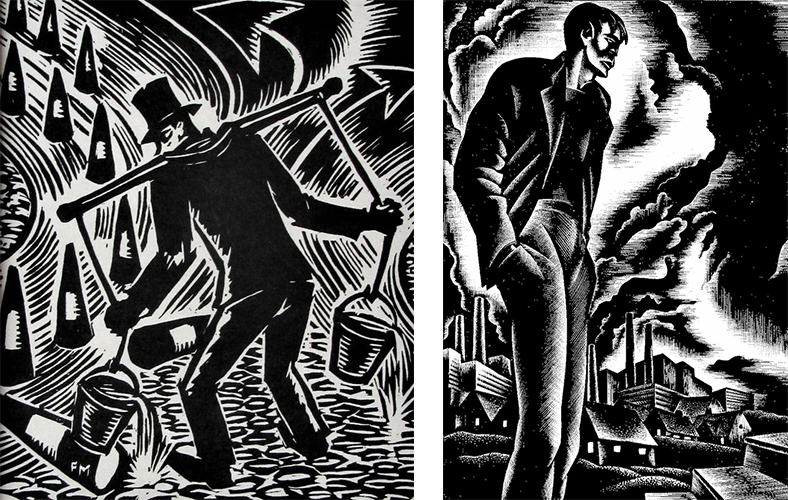
No hay comentarios:
Publicar un comentario